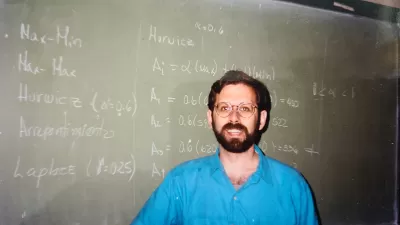As planning students and recent graduates consider internships and first jobs, they often ask how much these initial decisions matter. A conversation with Professor Robert Freestone unpacks the twists and turns of planning careers.

As planning students and recent graduates consider internships and first jobs, they often ask me how much these initial decisions determine their future path. They worry that their first job is not the job of their dreams. They are concerned that they don’t know exactly where they will be in five or ten years. I tell them that, on average, one’s first job is not their last job and that, even with a lot of planning, the careers of urban planners tend to twist and turn. However, these are my observations.
Recently, planning historian Professor Robert Freestone of the University of New South Wales, interviewed me about my very early career. I was one of over twenty interviewees, and I realized that Professor Freestone had a terrific set of data to answer questions about the trajectories of planning careers.
As Professor Freestone explained:
“Focused on a cohort .... who attained professional and/or academic prominence before 2000, all had continuing careers and public recognition. Some of the older informants, while attaining prominence in planning, had had knockabout early careers that were either far removed from or only on the fringes of planning, but they worked their way through, following their interests and opportunities presented, into the mainstream.”
I asked, on balance, did people plan their planning careers or sort of fall into them, taking up opportunities that emerged? As Professor Freestone described, those who early on saw they wanted to be planners got those qualifications. But, he continued:
“The journey to breakthrough or career-defining positions was mostly opportunistic…. The majority of interviewees had no master plan for steering or managing their own careers, responding to circumstances, opportunities, and roadblocks. This wasn’t an aimless and dispiriting process but one through which experience and credentials were being gained, positioning individuals for decisive employment that became the main accelerator. For individuals who gained a master's qualification in planning, the most common first degree and professional experience was in architecture. Almost universally, the transition was made when the young architects were frustrated by the low-level routine level of design and/or their interest in the wider urban environment. The overall impression is a diversity of paths variously into masters study, higher degree research, and engaging positions.”
I was interested that in the past half century, there have been a lot of periods of uncertainty that affected young planners. While those coming of age in the 1960s and 1970s faced very low unemployment, that was not the case for those graduating in the early 1980s and early 1990s. At that time, unemployment rates for this age group were higher than even in the recent COVID-19 spike. However, as Professor Freestone explained:
“While job and study decisions were driven by opportunity, they were usually constrained to what came up rather than an optimal pick from a suite of possibilities. The state of the job market at the time was a factor in deciding upon next moves but more often it was personal and family circumstances that loomed larger.”
Overall, these findings from Australian planners coincide with my observations about careers elsewhere. Of course, planners like to plan their careers, but it is impossible to do this in fine detail. Part of planning is getting into a position to make the best of opportunities when they emerge. For a profession of people drawn toward wanting to manage the future more proactively, that can be a challenge (in careers and in work). However, planning is also about engaging with others over time to develop an evolving picture of the best path forward. That attitude can be helpful as beginning planners start out, thinking flexibly about how to achieve the ultimate goal of a worthwhile career.
I have had a bit of a hiatus from Planetizen columns, consumed with being a program director, department chair, and Editor of the Journal of the American Planning Association (2019-2023). However, now I am returning to blogging. In addition to blogging about advice for students I will also highlight research useful for planning practice.

Trump Administration Could Effectively End Housing Voucher Program
Federal officials are eyeing major cuts to the Section 8 program that helps millions of low-income households pay rent.

Planetizen Federal Action Tracker
A weekly monitor of how Trump’s orders and actions are impacting planners and planning in America.

The 120 Year Old Tiny Home Villages That Sheltered San Francisco’s Earthquake Refugees
More than a century ago, San Francisco mobilized to house thousands of residents displaced by the 1906 earthquake. Could their strategy offer a model for the present?

HSR Reaches Key Settlement in Northern California City
The state’s high-speed rail authority reached an agreement with Millbrae, a key city on the train’s proposed route to San Francisco.

Washington State Legislature Passes Parking Reform Bill
A bill that would limit parking requirements for new developments is headed to the governor’s desk.

Missouri Law Would Ban Protections for Housing Voucher Users
A state law seeks to overturn source-of-income discrimination bans passed by several Missouri cities.
Urban Design for Planners 1: Software Tools
This six-course series explores essential urban design concepts using open source software and equips planners with the tools they need to participate fully in the urban design process.
Planning for Universal Design
Learn the tools for implementing Universal Design in planning regulations.
Ada County Highway District
Clanton & Associates, Inc.
Jessamine County Fiscal Court
Institute for Housing and Urban Development Studies (IHS)
City of Grandview
Harvard GSD Executive Education
Toledo-Lucas County Plan Commissions
Salt Lake City
NYU Wagner Graduate School of Public Service






























